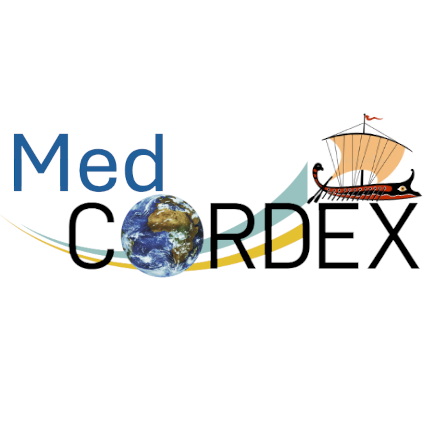Regional Climate System models allow to reproduce medium scale atmospheric and oceanic phenomena on periods going from present time hindcast to scenarios for the 21st century. Atmosphere, aerosol, land surface and sea-ice are grouped in one executable (ALADIN), river routing (CTRIP), ocean (NEMOMED12); the models are coupled with OASIS3-MCT, the outputs are managed by XIOS. Each version of CNRM-RCSM6 uses the last versions of ALADIN, CTRIP and NEMOMED12 available at a given time.
An example how to add an image. Upload to the images/ folder and voilà!
 or even simpler if the image is already available online (no need to upload anything):
or even simpler if the image is already available online (no need to upload anything):

Further information:
Table of Contents
Atmosphere
Grid: 12.5 km, 613x405, 91L
Regional climate model developed at CNRM, sharing the same physics as the global model ARPEGE-Climat (Roehrig et al. 2020).
Physics
| Physics | Scheme | Details | Reference |
|---|---|---|---|
| SW radiation | FMR | FMR 6 bands | Fouquart and Bonnel (1980) Morcrette et al. (2008) |
| LW radiation | RRTM | Rapid radiative transfer model | Mlawer et al. (1997) |
| Convection | PCMT | Prognostic Condensates Microphysics and Transport is a convection scheme representing in a unified way dry, shallow and deep convection. | Piriou et al. (2007) Guérémy (2011) |
| Shallow conv. | PCMT | Prognostic Condensates Microphysics and Transport is a convection scheme representing in a unified way dry, shallow and deep convection. | Piriou et al. (2007) Guérémy (2011) |
| Microphysics | Lopez 2002 | Large-scale microphysics scheme which describes liquid and ice particles as well as rain and snow using prognostic variables. | Lopez et al. (2002) |
| PBL | Cuxart 2000 | Cuxart et al. (2000) |
Radiation
The radiative forcings include non-interactive greenhouse gases, tropospheric and stratospheric aerosols, ozone and solar. Greenhouse gases are CO2, N2O, CH4, CFC12 and a CFC11-equivalent species that includes the effects of all the other GHGs of the original data set (39 species). The solar constant uses the CMIP6 advised value (Matthes et al., 2017) including a 11-year cycle.
Further info: Nabat et al. (2020)
Land surface
Grid: 12.5 km, 613x405, 14L
SURFEXv8.0 encompasses several submodules for modeling the interactions between the atmosphere, the ocean, the lakes and the land surface. The FLAKE model simulate surface fluxes over lakes, including both the Caspian and the Aral seas, and computes the temporal evolution of the vertical lake temperature profile from the surface mixing layer to the bottom (Le Moigne et al. 2016). The land surface is represented using the new ISBA-CTRIP coupled system (Decharme et al., 2019; Delire et al. 2019). ISBA calculates the time evolution of the energy, carbon and water budgets at the land surface while CTRIP simulates river discharges (including carbon transport) up to the ocean from the total runoff (and total soil carbon leaching) computed by ISBA.
Further info: Decharme et al. (2019)
Physics
| Physics | Scheme | Details | Reference |
|---|---|---|---|
| Soil | ISBA | ||
| Urban | none | ||
| Lake | FLake vX.X | FLAKE single column model | Mironov (2008) |
| Glacier | none | ||
| River routing | ISBA-CTRIP vx.x | CTRIP is a river routing model used to convert the daily runoff simulated by ISBA into river discharge on the global river channel network at 1/12-degree resolution. | Decharme et al. (2019) Munier and Decharme (2022) |
The soil hydrology uses the mixed form of the Richards equation to describe the water‐mass transfer within the soil via Darcy’s law. The one‐dimensional Fourier law is used to simulate temperature diffusion. ISBA is sub-divided in 12 patches in order to account for the variety of soil and vegetation behaviors within a grid point. Energy and water balances are calculated separately on each patch.”
Aerosol
Grid: 12.5 km, 613x405, 91L
Fully interactive: Sea salt, Desert Dust; Interactive + CMIP6 emission: Black Carbon, Organic Matter, Sulfate, Nitrate, Ammonium; CMIP6 dataset: Evolving Monthly AOD for Volcanic. Emissions: Natural (sea-salt and dust) emissions are dynamic (fully interactive). Fossil-fuel and biomass burning CMIP6 inventories are used for sulphate precursors, black carbon and organic matter.
Ocean
Grid: degree, 567x264, 75L
Regional version on the Mediterranean Sea of NEMOv3.6
SSTs outside the ocean model are daily interpolated from GCM monthly dataset.
Further info: Beuvier et al. (2012) Hamon et al. (2016) Waldman et al. (2018) Sevault (2024)
Spin-up strategy
The different components have been spun up independently. The ocean component …
Model tuning
For the atmosphere, a machine-learning based approach called “history matching”, adaptation to RCM of the approach described in Hourdin et al. (2021) and Couvreux et al. (2021). No tuning for the river routing model.
